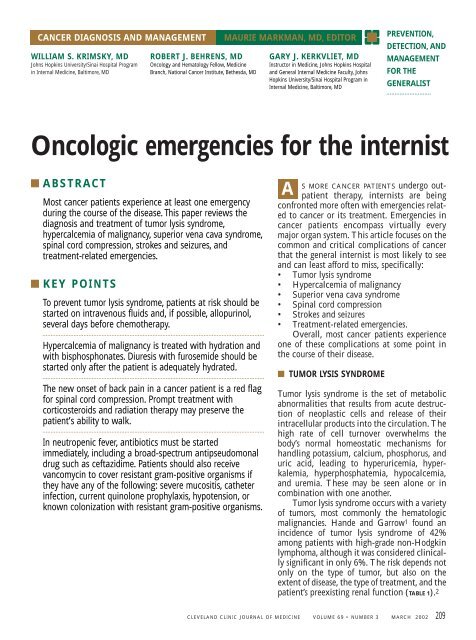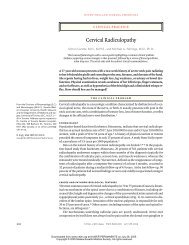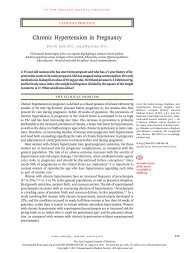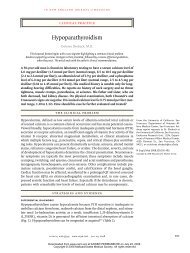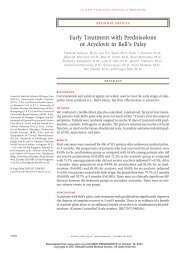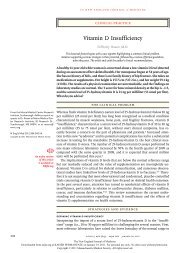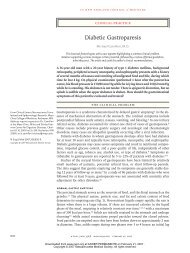Oncologic emergencies for the internist - Cleveland Clinic Journal of ...
Oncologic emergencies for the internist - Cleveland Clinic Journal of ...
Oncologic emergencies for the internist - Cleveland Clinic Journal of ...
Create successful ePaper yourself
Turn your PDF publications into a flip-book with our unique Google optimized e-Paper software.
CANCER DIAGNOSIS AND MANAGEMENTWILLIAM S. KRIMSKY, MDJohns Hopkins University/Sinai Hospital Programin Internal Medicine, Baltimore, MDROBERT J. BEHRENS, MDOncology and Hematology Fellow, MedicineBranch, National Cancer Institute, Be<strong>the</strong>sda, MDMAURIE MARKMAN, MD, EDITORGARY J. KERKVLIET, MDInstructor in Medicine, Johns Hopkins Hospitaland General Internal Medicine Faculty, JohnsHopkins University/Sinai Hospital Program inInternal Medicine, Baltimore, MDPREVENTION,DETECTION, ANDMANAGEMENTFOR THEGENERALIST<strong>Oncologic</strong> <strong>emergencies</strong> <strong>for</strong> <strong>the</strong> <strong>internist</strong>■ ABSTRACTMost cancer patients experience at least one emergencyduring <strong>the</strong> course <strong>of</strong> <strong>the</strong> disease. This paper reviews <strong>the</strong>diagnosis and treatment <strong>of</strong> tumor lysis syndrome,hypercalcemia <strong>of</strong> malignancy, superior vena cava syndrome,spinal cord compression, strokes and seizures, andtreatment-related <strong>emergencies</strong>.■ KEY POINTSTo prevent tumor lysis syndrome, patients at risk should bestarted on intravenous fluids and, if possible, allopurinol,several days be<strong>for</strong>e chemo<strong>the</strong>rapy.Hypercalcemia <strong>of</strong> malignancy is treated with hydration andwith bisphosphonates. Diuresis with furosemide should bestarted only after <strong>the</strong> patient is adequately hydrated.The new onset <strong>of</strong> back pain in a cancer patient is a red flag<strong>for</strong> spinal cord compression. Prompt treatment withcorticosteroids and radiation <strong>the</strong>rapy may preserve <strong>the</strong>patient’s ability to walk.In neutropenic fever, antibiotics must be startedimmediately, including a broad-spectrum antipseudomonaldrug such as ceftazidime. Patients should also receivevancomycin to cover resistant gram-positive organisms if<strong>the</strong>y have any <strong>of</strong> <strong>the</strong> following: severe mucositis, ca<strong>the</strong>terinfection, current quinolone prophylaxis, hypotension, orknown colonization with resistant gram-positive organisms.AS MORE CANCER PATIENTS undergo outpatient<strong>the</strong>rapy, <strong>internist</strong>s are beingconfronted more <strong>of</strong>ten with <strong>emergencies</strong> relatedto cancer or its treatment. Emergencies incancer patients encompass virtually everymajor organ system. This article focuses on <strong>the</strong>common and critical complications <strong>of</strong> cancerthat <strong>the</strong> general <strong>internist</strong> is most likely to seeand can least af<strong>for</strong>d to miss, specifically:• Tumor lysis syndrome• Hypercalcemia <strong>of</strong> malignancy• Superior vena cava syndrome• Spinal cord compression• Strokes and seizures• Treatment-related <strong>emergencies</strong>.Overall, most cancer patients experienceone <strong>of</strong> <strong>the</strong>se complications at some point in<strong>the</strong> course <strong>of</strong> <strong>the</strong>ir disease.■ TUMOR LYSIS SYNDROMETumor lysis syndrome is <strong>the</strong> set <strong>of</strong> metabolicabnormalities that results from acute destruction<strong>of</strong> neoplastic cells and release <strong>of</strong> <strong>the</strong>irintracellular products into <strong>the</strong> circulation. Thehigh rate <strong>of</strong> cell turnover overwhelms <strong>the</strong>body’s normal homeostatic mechanisms <strong>for</strong>handling potassium, calcium, phosphorus, anduric acid, leading to hyperuricemia, hyperkalemia,hyperphosphatemia, hypocalcemia,and uremia. These may be seen alone or incombination with one ano<strong>the</strong>r.Tumor lysis syndrome occurs with a variety<strong>of</strong> tumors, most commonly <strong>the</strong> hematologicmalignancies. Hande and Garrow 1 found anincidence <strong>of</strong> tumor lysis syndrome <strong>of</strong> 42%among patients with high-grade non-Hodgkinlymphoma, although it was considered clinicallysignificant in only 6%. The risk depends notonly on <strong>the</strong> type <strong>of</strong> tumor, but also on <strong>the</strong>extent <strong>of</strong> disease, <strong>the</strong> type <strong>of</strong> treatment, and <strong>the</strong>patient’s preexisting renal function (TABLE 1). 2CLEVELAND CLINIC JOURNAL OF MEDICINE VOLUME 69 • NUMBER 3 MARCH 2002 209
ONCOLOGIC EMERGENCIESKRIMSKY AND COLLEAGUESHyperkalemia is<strong>the</strong> most lifethreateningproblem intumor lysissyndromeNot available <strong>for</strong>online publication.See print version <strong>of</strong> <strong>the</strong><strong>Cleveland</strong> <strong>Clinic</strong> <strong>Journal</strong><strong>of</strong> MedicineFeatures <strong>of</strong> tumor lysis syndromeHyperuricemia. Catabolism <strong>of</strong> largeamounts <strong>of</strong> both RNA and DNA causes uricacid levels to rise fairly quickly. Normally, uricacid remains in <strong>the</strong> ionized state in <strong>the</strong> body;however, increased levels can lead to urateprecipitation in <strong>the</strong> distal tubule. 3 The result<strong>of</strong> precipitation is an overall decrease in renalfunction.Hyperphosphatemia and hypocalcemiaalso result from <strong>the</strong> above process. Phosphatelevels in neoplastic cells can be as much as fourtimes higher than in normal cells. 4,5 Thebreakdown and release <strong>of</strong> phosphate is initiallycompensated <strong>for</strong> by increased renal excretion.However, as <strong>the</strong> concentration <strong>of</strong> phosphateincreases, it combines with calcium and precipitatesin <strong>the</strong> renal tubule as well as in <strong>the</strong>s<strong>of</strong>t tissues. Consequently, hypocalcemia andrenal failure develop. 6 <strong>Clinic</strong>ally, hypocalcemiacan manifest as agitation, tetany, andbone pain.Hyperkalemia is perhaps <strong>the</strong> most lifethreateningderangement in tumor lysis syndrome.The sudden increase in potassiumresults in <strong>the</strong> well-defined clinical presentation<strong>of</strong> cardiac arrhythmias and death.All <strong>the</strong> above metabolic derangements aremade worse by preexisting renal insufficiency.Treatment <strong>of</strong> tumor lysis syndromeProphylaxis is <strong>the</strong> first step in treatment (TABLE2). 7 If a patient is found to be at high risk <strong>for</strong>tumor lysis syndrome, he or she shouldpromptly be started on both intravenous fluidand allopurinol if <strong>the</strong>re is no contraindicationto it. Close observation during <strong>the</strong>rapy is alsoessential, as transient, urgent hemodialysismay reverse <strong>the</strong> toxicity.■ HYPERCALCEMIA OF MALIGNANCYHypercalcemia <strong>of</strong> malignancy occurs inapproximately 10% to 20% <strong>of</strong> cancerpatients, 8,9 most <strong>of</strong>ten with lung cancer,breast cancer, and <strong>the</strong> hematologic malignanciessuch as multiple myeloma and lymphoma.10Features <strong>of</strong> hypercalcemia <strong>of</strong> malignancySymptoms vary depending on <strong>the</strong> degree <strong>of</strong>hypercalcemia and how quickly it develops.Acute symptoms include nausea, vomiting,constipation, polyuria, polydipsia, muscleweakness, acute renal insufficiency, and mentalstatus changes. Chronic symptoms includekidney stones, bone pain, and depression.Mechanisms <strong>of</strong> hypercalcemia<strong>of</strong> malignancyNormally, calcium levels are maintained by<strong>the</strong> interaction <strong>of</strong> parathyroid hormone, calcitonin,and 1,25(OH) 2 -vitamin D. The disorders<strong>of</strong> calcium metabolism in malignancyusually represent an alteration in one <strong>of</strong> <strong>the</strong>sepathways or extensive lytic bone lesions.Parathyroid hormone-related peptide.The most common cause <strong>of</strong> hypercalcemia <strong>of</strong>malignancy, classically seen in squamous celllung cancer, is a syndrome mediated by production<strong>of</strong> a parathyroid hormone-related peptide(PTHrP). Structurally similar to PTH at<strong>the</strong> amino acid terminus, PTHrP binds toparathyroid hormone receptors, mobilizes calciumfrom bones, and increases renal reabsorption<strong>of</strong> calcium. Evidence suggests that<strong>the</strong>re might be some clinical utility to measuringPTHrP because significant elevations <strong>of</strong>PTHrP seem to correlate with poorer outcomes.11–13Abnormal production <strong>of</strong> calcitriol (1,25-vitamin D). The deregulated conversion <strong>of</strong>210 CLEVELAND CLINIC JOURNAL OF MEDICINE VOLUME 69 • NUMBER 3 MARCH 2002
Not available <strong>for</strong> online publication.See print version <strong>of</strong> <strong>the</strong><strong>Cleveland</strong> <strong>Clinic</strong> <strong>Journal</strong> <strong>of</strong> Medicine25-vitamin D to 1,25-vitamin D appears to beresponsible <strong>for</strong> some <strong>of</strong> <strong>the</strong> hypercalcemia <strong>of</strong>malignancy seen in both Hodgkin lymphomaand non-Hodgkin lymphoma. 14,15 Thus, it issimilar to <strong>the</strong> hypercalcemia associated withsarcoidosis and o<strong>the</strong>r granulomatous diseases.Direct tumor invasion into bony structures.Individual tumor cells secrete a variety<strong>of</strong> mediators, including interleukin-1, interleukin-6,and tumor necrosis factor, that upregulatelocal osteoclastic activity, causingcalcium to be released into <strong>the</strong> serum. 16Treatment <strong>of</strong> hypercalcemia <strong>of</strong> malignancyTreatment must address <strong>the</strong>se various mechanismsto be effective; ideally, <strong>the</strong> best way is byreducing or eliminating <strong>the</strong> causative malignancy.Hydration. Patients with hypercalcemia<strong>of</strong> malignancy invariably present with somedehydration caused by calcium’s effect on <strong>the</strong>kidney. Thus, appropriate managementshould begin with giving intravenous fluids toimprove symptoms and to induce excretion <strong>of</strong>calcium. However, even with adequatehydration, most patients do not achieve anacceptable calcium level, and thus additional<strong>the</strong>rapies are used to control <strong>the</strong> renal andskeletal mechanisms <strong>of</strong> hypercalcemia <strong>of</strong>malignancy.Diuresis with furosemide increases renalexcretion <strong>of</strong> calcium, but should be startedonly when <strong>the</strong> patient has been adequatelyhydrated—o<strong>the</strong>rwise it will exacerbate <strong>the</strong>free water loss relative to <strong>the</strong> loss <strong>of</strong> sodiumand calcium.Bisphosphonates. Most experts recommendusing bisphosphonates, most <strong>of</strong>tenpamidronate, to produce a sustained decreasein <strong>the</strong> calcium level by inhibiting osteoclasticactivity and calcium resorption from bone. 17Pamidronate is given intravenously in ei<strong>the</strong>r aHypercalcemicpatientsinvariably aredehydratedCLEVELAND CLINIC JOURNAL OF MEDICINE VOLUME 69 • NUMBER 3 MARCH 2002 213
ONCOLOGIC EMERGENCIESKRIMSKY AND COLLEAGUESExpertsrecommendpursuing atissue diagnosisin superior venacava syndrome60-mg or a 90-mg dose over at least 2 hours. 18Approximately 60% <strong>of</strong> patients respond to a60-mg dose and nearly 100% to a 90-mgdose. 19 Pamidronate usually takes approximately12 to 48 hours to produce an initialresponse, and <strong>the</strong> response is sustained <strong>for</strong> anaverage <strong>of</strong> about 2 weeks. 20Calcitonin is frequently used in additionto bisphosphonates because it has a rapidonset <strong>of</strong> effect: within 2 to 4 hours <strong>of</strong> administration.21 Its main drawbacks are hypersensitivityreactions and tachyphylaxis; <strong>the</strong> latterusually develops within 3 days.Gallium nitrate and plicamycin are usedinfrequently because <strong>of</strong> <strong>the</strong>ir toxicity.Steroids are frequently helpful in <strong>the</strong>short term, especially in sensitive tumors suchas lymphoma and myeloma.Dialysis remains an option <strong>for</strong> those whocannot tolerate a saline load.■ SUPERIOR VENA CAVA SYNDROMESuperior vena cava syndrome is relatively rare,affecting 2.4% to 4.2% <strong>of</strong> lung cancerpatients, who account <strong>for</strong> 65% <strong>of</strong> all cases. 22Small cell lung cancer is <strong>the</strong> most frequentcause <strong>of</strong> <strong>the</strong> syndrome because it has apredilection <strong>for</strong> <strong>the</strong> central region <strong>of</strong> <strong>the</strong>lungs. 23 Lymphoma accounts <strong>for</strong> 8% <strong>of</strong> cases,and breast cancer and o<strong>the</strong>r mediastinalmetastatic lesions account <strong>for</strong> 10%. 22Of note: several nonmalignant diseasessuch as granulomatous and fibrosing mediastinitis,goiters, and aortic aneurysms can alsocause superior vena cava syndrome.Features <strong>of</strong> superior vena cava syndromeSuperior vena cava syndrome results from anincrease in central venous pressure caused byvena caval obstruction. Typically this producescough, dyspnea, and dysphagia combinedwith swelling and discoloration <strong>of</strong> <strong>the</strong>neck, face, or upper extremities. Dependingon <strong>the</strong> site <strong>of</strong> <strong>the</strong> disease, both vocal cordparalysis and Horner syndrome (sinking in <strong>of</strong><strong>the</strong> eyeball, ptosis <strong>of</strong> <strong>the</strong> upper eyelid, elevation<strong>of</strong> <strong>the</strong> lower lid, constriction <strong>of</strong> <strong>the</strong> pupil,narrowing <strong>of</strong> <strong>the</strong> palpebral fissure, andanhidrosis and flushing <strong>of</strong> <strong>the</strong> affected side <strong>of</strong><strong>the</strong> face; caused by compression <strong>of</strong> sympa<strong>the</strong>ticnerves) can occur.Treatment <strong>of</strong> superior vena cava syndromeInitial treatment consists <strong>of</strong> elevating <strong>the</strong>head <strong>of</strong> <strong>the</strong> bed and giving diuretics and corticosteroids.However, corticosteroids are moreuseful when <strong>the</strong> cause <strong>of</strong> <strong>the</strong> obstruction islymphoma ra<strong>the</strong>r than lung cancer.Chemo<strong>the</strong>rapy and radiation <strong>the</strong>rapy.Unless tracheal obstruction is present orimpending, superior vena cava syndrome isnot immediately life-threatening, and mostexperts recommend pursuing a tissue diagnosisso that specific treatment can be given <strong>for</strong> <strong>the</strong>primary tumor alongside treatment <strong>for</strong> <strong>the</strong>symptoms. 22Both primary chemo<strong>the</strong>rapy and radiationare important components <strong>of</strong> <strong>the</strong>rapy. In smallcell lung cancer, Chan et al 24 found no differencein <strong>the</strong> response rate in patients whoreceived chemo<strong>the</strong>rapy compared with radiation<strong>the</strong>rapy. The recurrence rate <strong>of</strong> superiorvena cava syndrome depends on <strong>the</strong> type <strong>of</strong>tumor causing <strong>the</strong> obstruction. In large celllymphoma <strong>the</strong> high risk <strong>of</strong> recurrence withchemo<strong>the</strong>rapy resulted in a recommendationto use radiation <strong>the</strong>rapy. 25Intravenous stenting can relieve symptoms,particularly dyspnea, <strong>for</strong> most patients.Anticoagulation. Thrombus <strong>for</strong>mationoccurs in up to 50% <strong>of</strong> patients with superiorvena cava syndrome. In a small study,Adelstein et al 26 attempted prophylaxis withfull doses <strong>of</strong> heparin and warfarin but found itconferred no survival advantage when treatedpatients were compared with 10 historicalcontrols. However, anticoagulation is stillused <strong>for</strong> symptom relief regardless <strong>of</strong> effect onsurvival.■ SPINAL CORD COMPRESSIONSpinal cord compression is not immediatelylife-threatening unless it involves level C3 orabove, but it may lead to pr<strong>of</strong>ound, permanentmorbidity. Paraplegia or loss <strong>of</strong> sphincter controlor both not only diminishes a patient’squality <strong>of</strong> life but also predisposes to fur<strong>the</strong>rcomplications such as venous thrombosis,decubitus ulcers, and urinary obstruction.Spinal cord compression occurs at sometime in approximately 5% <strong>of</strong> all cancerpatients, 27 most <strong>of</strong>ten in carcinomas <strong>of</strong> <strong>the</strong>prostate, lung, and breast.214 CLEVELAND CLINIC JOURNAL OF MEDICINE VOLUME 69 • NUMBER 3 MARCH 2002
ONCOLOGIC EMERGENCIESKRIMSKY AND COLLEAGUESMRI withoutcontrast is <strong>the</strong>best test <strong>for</strong>spinal cordcompressionFeatures <strong>of</strong> spinal cord compressionPain is <strong>the</strong> primary symptom and iseventually reported in 96% <strong>of</strong> patients withspinal cord compression. 28 The pain may beacute or may gradually increase over weeks.Although <strong>the</strong> pain is similar to that <strong>of</strong> discdisease, one potential difference is that <strong>the</strong>pain <strong>of</strong> spinal cord compression can beincreased in <strong>the</strong> supine position anddecreased when upright.O<strong>the</strong>r signs and symptoms are weakness,sensory deficits, and autonomic dysfunction.Diagnosis <strong>of</strong> spinal cord compressionIt is <strong>of</strong>ten difficult to decide whe<strong>the</strong>r a patientwith back pain should be thoroughly evaluatedto exclude spinal cord compression, but apatient with known or suspected metastaticdisease (especially tumor types with a tropism<strong>for</strong> bone) presenting with a new pain patternor a neurologic deficit deserves meticulousevaluation.Magnetic resonance imaging (MRI)without contrast is <strong>the</strong> best and most costeffectivetest. 29Several nonmalignant conditions, suchas osteoporotic compression fractures andspinal abscesses, may also cause spinal cordcompression and must be diagnosed accurately,as <strong>the</strong>ir treatment and prognosis aremarkedly different.Treatment <strong>of</strong> spinal cord compressionNeurologic compromise can be rapid; <strong>the</strong>re<strong>for</strong>e,treatment must begin quickly after diagnosis.Corticosteroids are a critical part <strong>of</strong> <strong>the</strong>initial management because <strong>the</strong>y decreaseedema that may compress vasculature or <strong>the</strong>nerves directly and lead to permanent injury.Although dosages are debated, <strong>the</strong> minimumis dexamethasone 10 mg (or an equivalent) byintravenous bolus followed by 4 mg intravenouslyevery 6 hours.Radiation <strong>the</strong>rapy. Carcinomas <strong>of</strong> <strong>the</strong>prostate, lung, and breast are more predictablyresponsive to radio<strong>the</strong>rapy than are o<strong>the</strong>rtypes <strong>of</strong> tumors. However, a patient presentingwith any type <strong>of</strong> malignant spinal cord compressionshould also seen urgently by a radiationoncologist.Chemo<strong>the</strong>rapy may be an option <strong>for</strong>extremely chemosensitive tumors such aspediatric neuroblastomas.Surgery is <strong>the</strong> remaining option if a tissuediagnosis is needed, <strong>the</strong> area has previouslyreceived maximal irradiation, spinal stabilizationis needed, or o<strong>the</strong>r treatments are notworking.■ STROKES AND SEIZURESStrokes and seizures are common in cancerpatients. Strokes occur in 7% <strong>of</strong> all cancerpatients 30 and are equally split between hemorrhagicand thrombotic subtypes. Seizuresoccur in 2.7% <strong>of</strong> patients with cerebral metastasesand in 1.8% <strong>of</strong> cancer patients withoutbrain metastases. 31Initial treatment <strong>of</strong> strokes and seizures incancer patients is <strong>the</strong> same as in patients withoutcancer. After initial stabilization, specifictreatment <strong>of</strong> <strong>the</strong> tumor such as radio<strong>the</strong>rapyor steroids should be started. In addition,patients with thrombotic strokes might beconsidered candidates <strong>for</strong> antiplatelet, anticoagulation,or thrombolytic <strong>the</strong>rapy.Patients with cerebral metastasis withouta history <strong>of</strong> seizure should be advised not todrive or engage in activities in which an unexpectedseizure could harm <strong>the</strong>m or o<strong>the</strong>rs.Randomized studies have shown no benefitfrom prophylactic anticonvulsants, 32 withpossible exceptions <strong>for</strong> melanoma brainmetastases or leptomeningeal metastases.■ TREATMENT-RELATED EMERGENCIESExtravasation <strong>of</strong> chemo<strong>the</strong>rapeutic drugsExtravasation—leakage <strong>of</strong> chemo<strong>the</strong>rapeuticdrugs into <strong>the</strong> skin— results in pain, redness,swelling, and even necrosis. Its reported incidenceranges from 0.1% to 6.5% <strong>of</strong>chemo<strong>the</strong>rapy infusions. 33 Although <strong>the</strong>sereactions are usually seen in an oncologic setting,<strong>the</strong>y are increasingly being seen in <strong>the</strong>primary care physician’s <strong>of</strong>fice as morepatients undergo home infusion <strong>the</strong>rapy.Occasionally, symptoms may develophours or days after <strong>the</strong> initial insult. The delaycan be caused by endocytolysis, in which asmall amount <strong>of</strong> drug kills and lyses cells at<strong>the</strong> injection site and <strong>the</strong>n moves on repeat-216 CLEVELAND CLINIC JOURNAL OF MEDICINE VOLUME 69 • NUMBER 3 MARCH 2002
Not available <strong>for</strong> online publication.See print version <strong>of</strong> <strong>the</strong><strong>Cleveland</strong> <strong>Clinic</strong> <strong>Journal</strong> <strong>of</strong> Medicineedly to damage <strong>the</strong> surrounding tissues.Extravasation is important because largeareas <strong>of</strong> skin may break down, leading to poorcosmetic results, secondary infection, andcontractures if <strong>the</strong> injury is over a joint.The most common culprits are vesicants,which cause blisters when <strong>the</strong>y contact skin.Anthracyclines (eg, doxorubicin and idarubicin)and vinca alkaloids (eg, vincristine andvinorelbine) are <strong>the</strong> most common vesicantsused in clinical practice.If <strong>the</strong> patient is complaining <strong>of</strong> pain orproblems during vesicant infusion, <strong>the</strong> infusionshould be stopped, <strong>the</strong> line aspirated toremove residual drug, and an antidote (ifavailable) instilled through <strong>the</strong> line (TABLE 3). 33If using a port, disconnect <strong>the</strong> infusion line; ifusing a temporary intravenous line, discontinueit. Compression <strong>of</strong> <strong>the</strong> site should be avoidedas this may spread <strong>the</strong> remaining drug fur<strong>the</strong>rout from <strong>the</strong> injection site. The use <strong>of</strong>heat, ice, and antidotes depends on <strong>the</strong> specificchemo<strong>the</strong>rapeutic drug.If a patient presents to an <strong>internist</strong> withpain at an injection site, with or without redness,shortly after a chemo<strong>the</strong>rapy infusion, heor she should be referred to his or her treatingoncologist urgently.Neutropenic feverNeutropenic fever is common, and if it is leftuntreated <strong>the</strong> mortality rate is 50%. 34Neutropenia is defined as a neutrophilcount lower than 0.5 ×10 9 /L (500/mm 3 ), orless than 1.0 × 10 9 /L and expected to declinebelow 0.5 soon. A fever is defined as a singletemperature <strong>of</strong> 38.3˚C (101.0˚F) or higher, ora temperature <strong>of</strong> 38.0˚C (100.4˚F) or higherlasting over 1 hour.A complete fever workup should be completed,and <strong>the</strong>n antibiotics should be startedpromptly. All patients should receive a broadspectrumantipseudomonal drug such as ceftazidime.They also should receive vancomycinto cover resistant gram-positiveorganisms if any <strong>of</strong> <strong>the</strong> following is present:severe mucositis, ca<strong>the</strong>ter infection, currentquinolone prophylaxis, hypotension, orknown colonization with resistant gram-positiveorganisms. Often, despite a comprehensivesearch, <strong>the</strong> cause is never found; however,it is essential to start antibiotics immediatelyupon noting a neutropenic fever. Antibioticsshould be continued until <strong>the</strong> absolute neutrophilcount exceeds 0.5 × 10 9 /L and <strong>the</strong>patient is afebrile.It is important <strong>for</strong> <strong>the</strong> patient and all <strong>of</strong>his or her contacts to routinely wash <strong>the</strong>irhands.DehydrationOften overlooked, dehydration is a serious riskand is very common in cancer patients because<strong>of</strong> cachexia caused by <strong>the</strong> disease or its treat-Stop <strong>the</strong>infusion if <strong>the</strong>patientcomplains <strong>of</strong>pain duringvesicantinfusionCLEVELAND CLINIC JOURNAL OF MEDICINE VOLUME 69 • NUMBER 3 MARCH 2002 217
ONCOLOGIC EMERGENCIESKRIMSKY AND COLLEAGUESment. Dehydration is associated with deliriumin 30% <strong>of</strong> cancer patients and is linked toshorter survival. 35 Common treatment-relatedcauses include emesis, diarrhea, and mucositis.For example, in some series <strong>of</strong> colon cancerpatients, 36 approximately 50% required achange in treatment because <strong>of</strong> dehydrationand 20% required intravenous fluids.An <strong>internist</strong> can improve a patient’s quality<strong>of</strong> life by providing supportive care withfluids, antiemetics, and antidiarrheal drugsand by communicating with <strong>the</strong> oncologist todiscuss adverse effects that may require achange in treatment.■ REFERENCES1. Hande KR, Garrow GC. Acute tumor lysis syndrome inpatients with high grade non-Hodgkin’s lymphoma. Am JMed 1993; 94:133–139.2. Flombaum CD. Metabolic <strong>emergencies</strong> in <strong>the</strong> cancerpatient. Semin Oncol 2000; 27:322–334.3. Conger JD, Falk SA. Intrarenal dynamics in <strong>the</strong> pathogenesisand presentation <strong>of</strong> acute urate nephropathy. J ClinInvest 1977; 59:786–793.4. Zusman J, Brown DM, Nesbit ME. Hyperphosphatemia,hyperphosphaturia, and hypocalcemia in acute lymphoblasticleukemia. N Engl J Med 1973; 289:1335–1340.5. Rigas DA, Duerst ML, Jump ME, Osgood EE. The nucleicacids and o<strong>the</strong>r phosphorous compounds <strong>of</strong> humanleukemic leukocytes: relation to cell maturity. J Lab ClinMed 1956; 8:356–378.6. Ettinger DS, Harker WG, Gerry HW, Sanders RC, Saral R.Hyperphosphatemia, hypocalcemia, and transient renalfailure: results <strong>of</strong> cytotoxic treatment <strong>of</strong> acute lymphoblasticleukemia. JAMA 1978; 239:2472–2474.7. Flombaum C. Electrolyte and renal abnormalities. In:Groeger JS, editor: Critical Care <strong>of</strong> <strong>the</strong> Cancer Patient,2nd ed. St Louis, Mosby Year Book, 1991:140–164.8. Mundy GR, Guise TA. Hypercalcemia <strong>of</strong> malignancy. Am JMed 1997; 103:134–145.9. Morton AR, Lipton A. Hypercalcemia. In: Abel<strong>of</strong>f MD,Armitage JO, Lichter AS, Niederhuber JE, editors. <strong>Clinic</strong>alOncology. New York: Churchill Livingstone,2000:719–733.Anaphylaxis and capillary leakSome systemic treatments such as interleukin-2 (IL-2) may cause severe hypotension, especiallywhen given at high doses intravenously.The mechanism is decreased systemic vascularresistance and leakage out <strong>of</strong> vessels, leading tointravascular volume depletion. Somehypotension is seen in up to 70% <strong>of</strong> patientsreceiving IL-2 in high doses, and 3% experiencelife-threatening degrees <strong>of</strong> hypotension. 37Close monitoring in an intensive care unit iswise be<strong>for</strong>e starting such high-dose <strong>the</strong>rapy.The treatment is to not give more IL-2until <strong>the</strong> patient recovers and to provide supportivecare with intravenous fluids andphenylephrine. IL-2 in low doses rarely causessuch hypotension.Hemorrhagic cystitisSome chemo<strong>the</strong>rapeutic drugs have toxicmetabolites that are excreted by <strong>the</strong> kidneyand can cause severe bladder hemorrhage. Acommon example is acrolein, which is <strong>for</strong>medby <strong>the</strong> metabolism <strong>of</strong> cyclophosphamide andifosfamide.Hemorrhagic cystitis is more commonwhen urinary output is low, because low urineoutput increases <strong>the</strong> concentration <strong>of</strong> acroleinin <strong>the</strong> urine and <strong>the</strong> duration that <strong>the</strong> bladdermucosa is exposed to it. There<strong>for</strong>e, hydrating<strong>the</strong> patient be<strong>for</strong>e chemo<strong>the</strong>rapy is an importantpreventive measure. Ano<strong>the</strong>r preventivemeasure is to give mesna during chemo<strong>the</strong>rapyinfusion. 38If hemorrhage is severe, exsanguinationmay result. Blood transfusions and a urologyconsult are essential. Continuous bladderinfusions via a three-way ca<strong>the</strong>ter are commonlyused to prevent bladder clots andalso to flush out any remaining uro<strong>the</strong>lialtoxins. Measures as drastic as <strong>for</strong>maldehydebladder infusions or cystectomy are rarelyneeded.10. Warrell RP. Metabolic <strong>emergencies</strong>. In: DeVita VT, HellmanS, Rosenberg SA, editors. Cancer: Principles and Practice<strong>of</strong> Oncology. Philadelphia: Lippincott Williams & Wilkins,2001:2633.11. Gurney H, Grill V, Martin TJ. Parathyroid hormone-relatedprotein and response to pamidronate on tumor inducedhypercalcemia. Lancet 1993; 341:1611–1613.12. Pecherstorfer M, Schilling T, Blind E, et al. Parathyroidhormone-related protein and life expectancy in hypercalcemiccancer patients. J Clin Endocrinol Metab 1994;78:1268–1270.13. Wimalawansa SJ. Significance <strong>of</strong> plasma PTH-rP inpatients with hypercalcemia <strong>of</strong> malignancy treated withbisphosphonate. Cancer 1994; 73:2223–2230.14. Adams JS, Fernandez M, Gacad MA, et al. Vitamin Dmetabolite-mediated hypercalcemia and hypercalciuriapatients with AIDS- and non-AIDS-associated lymphoma.Blood 1989; 73:235–239.15. Breslau NA, McGuire JL, Zerwekh JE, Frenkel EP, Pak CY.Hypercalcemia associated with increased serum calcitriollevels in three patients with lymphoma. Ann Intern Med1984; 100:1–6.16. Klein B, Bataille R. Cytokine network in human multiplemyeloma. Hematol Oncol Clin North Am 1992;6(2):273–284.17. Mundy GR, Guise TA. Hypercalcemia <strong>of</strong> malignancy. Am JMed 1997; 103:134–145.18. Dodwell DJ, Howell A, Morton AR, Daley-Yates PT,Hoggarth CR. Infusion rate and pharmacokinetics <strong>of</strong>Dehydration iscommon and<strong>of</strong>tenoverlooked incancer patientsCLEVELAND CLINIC JOURNAL OF MEDICINE VOLUME 69 • NUMBER 3 MARCH 2002 221
KRIMSKY AND COLLEAGUESVisitOurWebsiteFor In<strong>for</strong>mationonOnline CME&Upcoming Courses• Great Lakes Thrombosis Update, April 20, 2002• Contrast Echocardiographyand New Technologies, May 8, 2002• Update in Headache Management, May 15, 2002intravenous pamidronate in <strong>the</strong> treatment <strong>of</strong> tumorinducedhypercalcemia. Postgrad Med J 1992; 68:434–439.19. Nussbaum SR, Younger J, Vandepol CJ. Single-dose intravenous<strong>the</strong>rapy with pamidronate <strong>for</strong> <strong>the</strong> treatment <strong>of</strong>hypercalcemia <strong>of</strong> malignancy: Comparison <strong>of</strong> 30-, 60-, and90-mg dosages. Am J Med 1993; 95:297–304.20. Wimalawansa SJ. Optimal frequency <strong>of</strong> administration <strong>of</strong>pamidronate in patients with hypercalcemia <strong>of</strong> malignancy.Clin Endocrinol 1994; 41:591–595.21. Warrell RP Jr, Israel R, Frisone M, Snyder T, Gaynor JJ,Bockman RS. Gallium nitrate <strong>for</strong> acute treatment <strong>of</strong> cancer-relatedhypercalcemia. A randomized double-blindcomparison to calcitonin. Ann Intern Med 1988;108:669–674.22. Yahalom J. Superior vena cava syndrome. In: DeVita VT,Hellman S, Rosenberg SA, editors. Cancer: Principles andPractice <strong>of</strong> Oncology. Philadelphia: Lippincott Williams &Wilkins, 2001:2609–2653.23. Sculier JP, Evans WK, Feld R, et al. Superior vena cavaobstruction in small cell lung cancer. Cancer 1986;57:847–851.24. Chan RH, Dar AR, Yu E, et al. Superior vena cava obstructionin small cell lung cancer. Int J Radiat Oncol Biol Phys1997; 38:513–520.25. Perez-Soler R, McLaughlin P, Velasquez WS, et al. <strong>Clinic</strong>alfeatures and results <strong>of</strong> management <strong>of</strong> superior vena cavasyndrome secondary to lymphoma. J Clin Oncol 1984;2:260–266.26. Adelstein DL, Hines JD, Carter SG, et al. Thromboembolicevents on patients with malignant superior vena cava syndromeand <strong>the</strong> role <strong>of</strong> cardiac function. Cancer 1988;62:2258–2262.27. Byrne TN. Spinal cord compression from epidural metastases.N Engl J Med 1992; 327:614–619.28. Gilbert RW, Kim J-H, Posner JB. Epidural spinal cord compressionfrom metastatic tumor: diagnosis and treatment.Ann Neurol 1978; 3:40–51.29. Fuller BG, Heiss JD, Oldfield EH. Spinal cord compression.In: DeVita VT, Hellman S, Rosenberg SA, editors. Cancer:Principles and Practice <strong>of</strong> Oncology. Philadelphia:Lippincott Williams & Wilkins, 2001:2623–2624.30. Schiff D, Batchelor T, Wen PY. Neurologic <strong>emergencies</strong> incancer patients. Neurol Clin 1998; 16:449–483.31. Clouston PD, DeAngelis LM, Posner JB. The spectrum <strong>of</strong>neurological disease in patients with systemic cancer. AnnNeurol 1992; 31:268–273.32. Schiff D, Batchelor T, Wen PY. Neurologic <strong>emergencies</strong> incancer patients. Neurol Clin 1998; 16:449–483.33. Albanell J, Baselga J. Systemic <strong>the</strong>rapy <strong>emergencies</strong>. SeminOncol 2000; 27:347–361.34. Hughes WT, Armstrong D, Bodey GP, et al. 1997Guidelines <strong>for</strong> <strong>the</strong> use <strong>of</strong> antimicrobial agents in neutropenicpatients with unexplained fever. Clin Infect Dis1997; 25:551–573.35. Lawlor PG, Gagnon B, Mancini IL, et al. Occurrence, causes,and outcome <strong>of</strong> delirium in patients with advancedcancer. Arch Intern Med 2000; 160:786–794.36. Arbuckle RB, Huber SL, Zacker C. The consequences <strong>of</strong>diarrhea occurring during chemo<strong>the</strong>rapy <strong>for</strong> colorectalcancer: a retrospective study. Oncologist 2000; 5:250–259.37. Physician’s Desk Reference in Micromedex; 1998.Druginfo.cc.nih.gov.38. Hensley ML, Schuchter LM, Lindley C, et al. AmericanSociety <strong>of</strong> <strong>Clinic</strong>al Oncology clinical practice guidelines <strong>for</strong><strong>the</strong> use <strong>of</strong> chemo<strong>the</strong>rapy and radio<strong>the</strong>rapy protectants. JClin Oncol 1999; 17:3333–3355.ADDRESS: Robert J. Behrens, MD, National Cancer Institute,Navy Building 8, Room 5101, Be<strong>the</strong>sda, MD 20892; e-mailbehrensr@mail.nih.gov.222 CLEVELAND CLINIC JOURNAL OF MEDICINE VOLUME 69 • NUMBER 3 MARCH 2002


